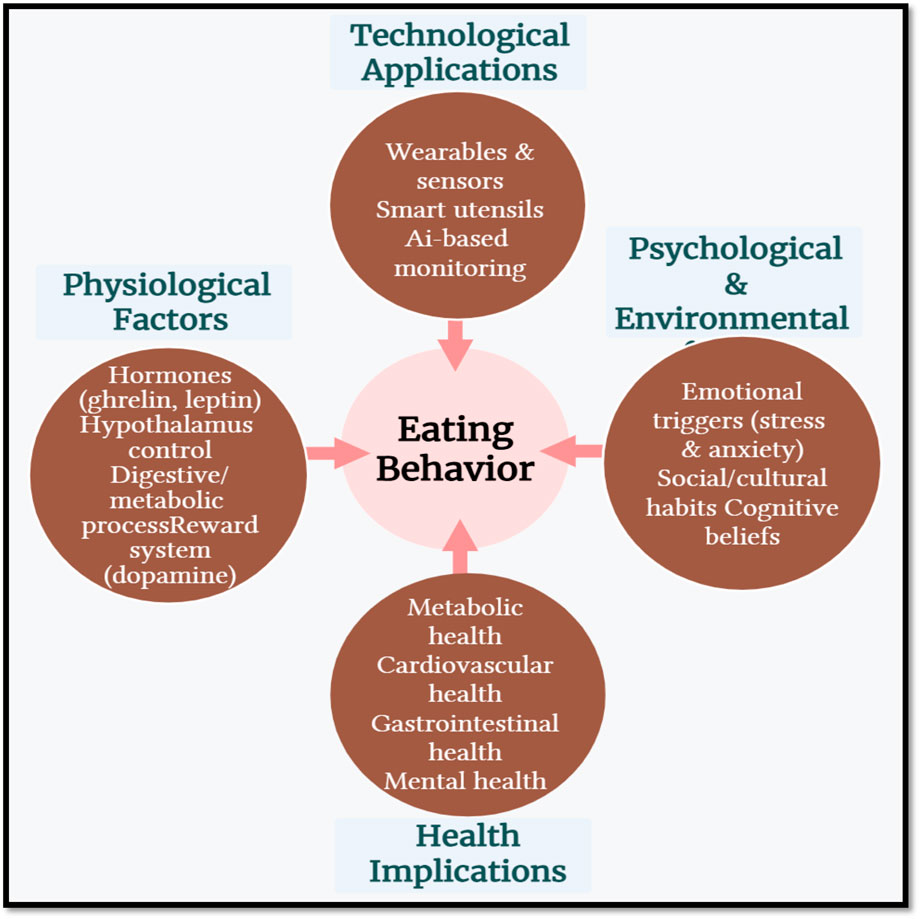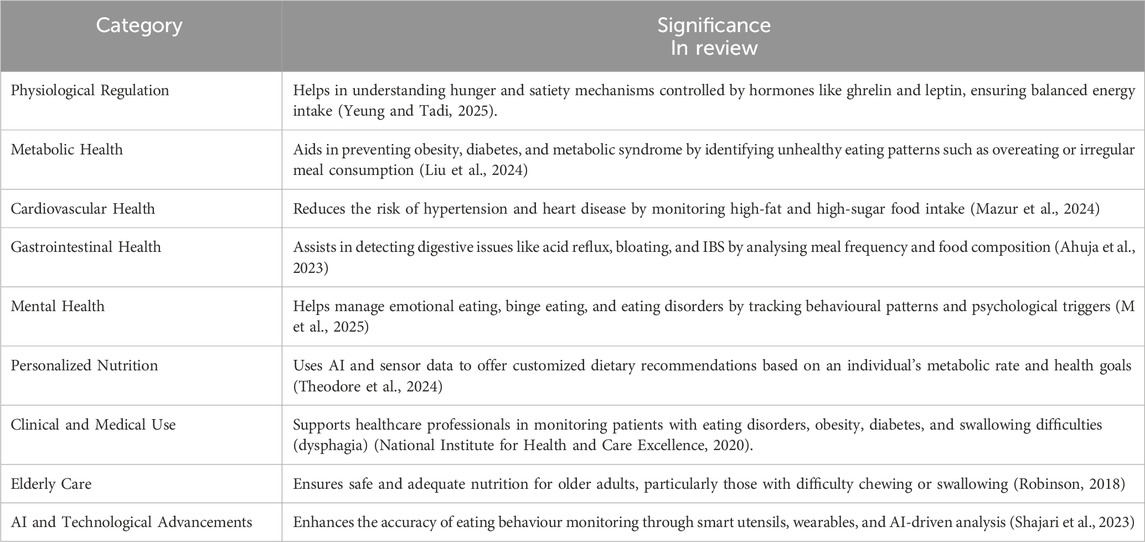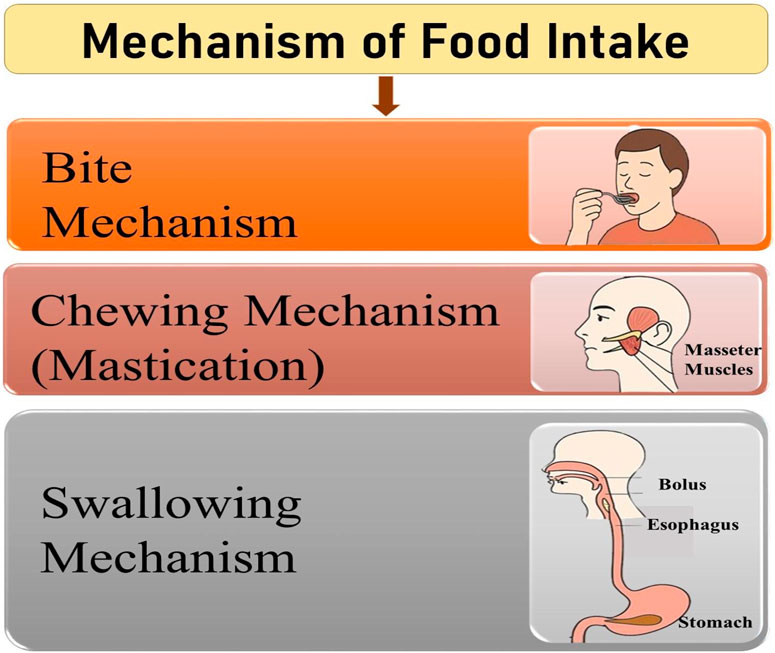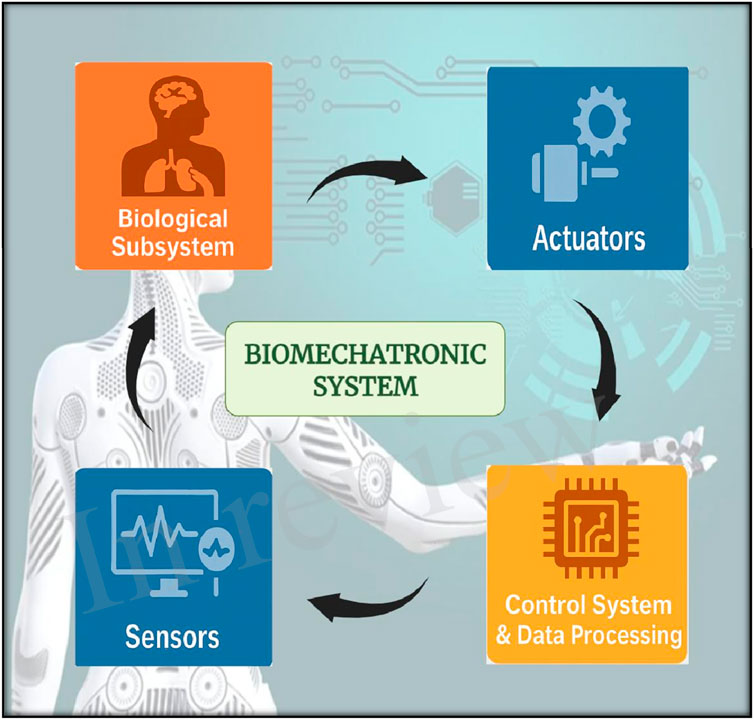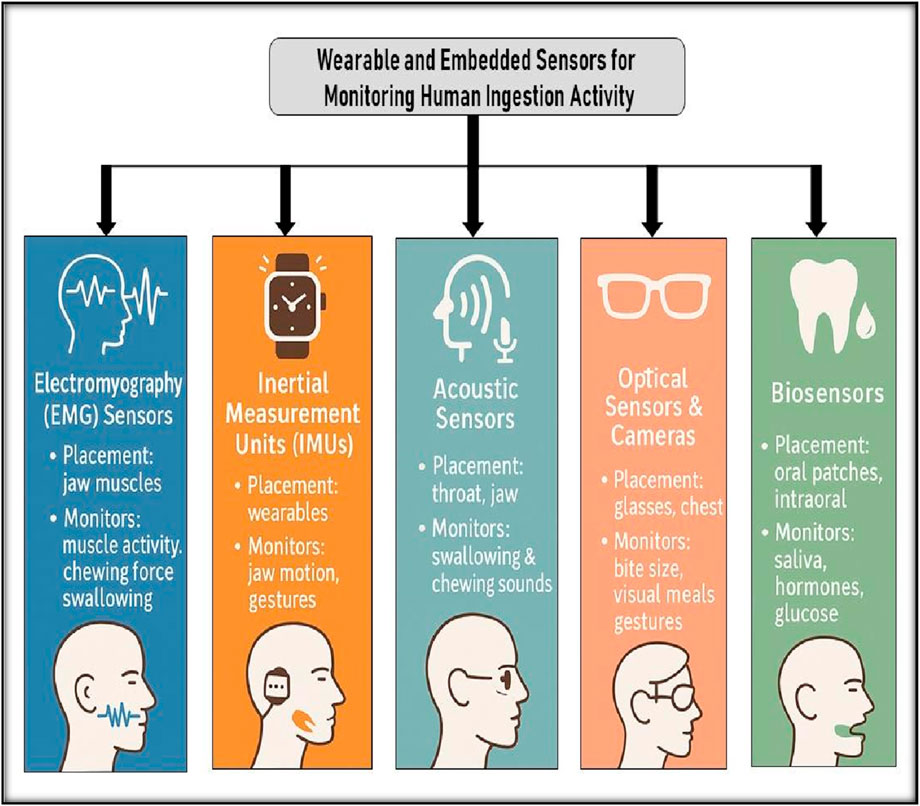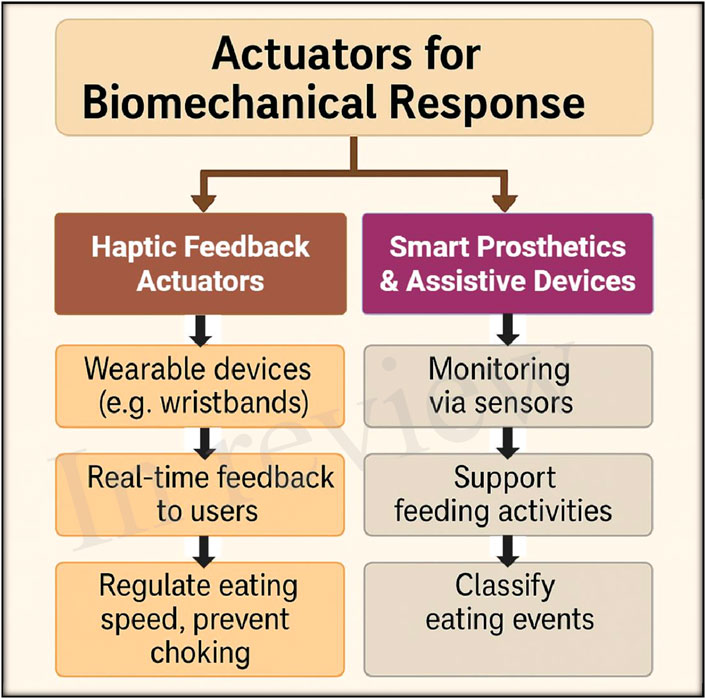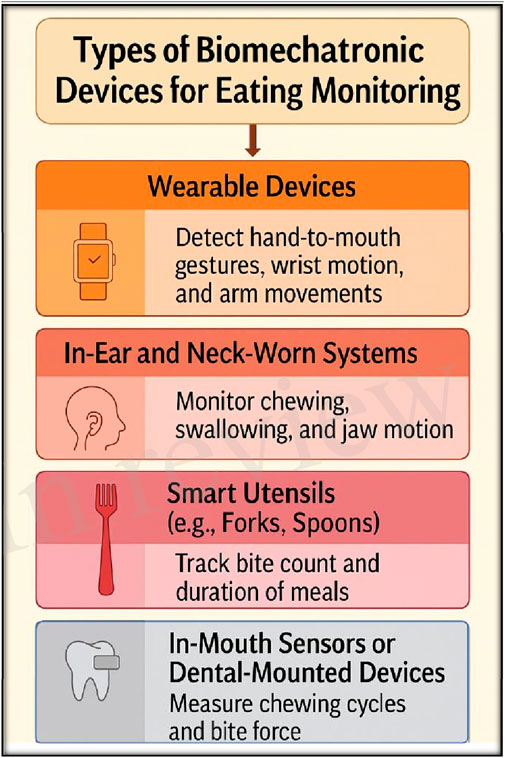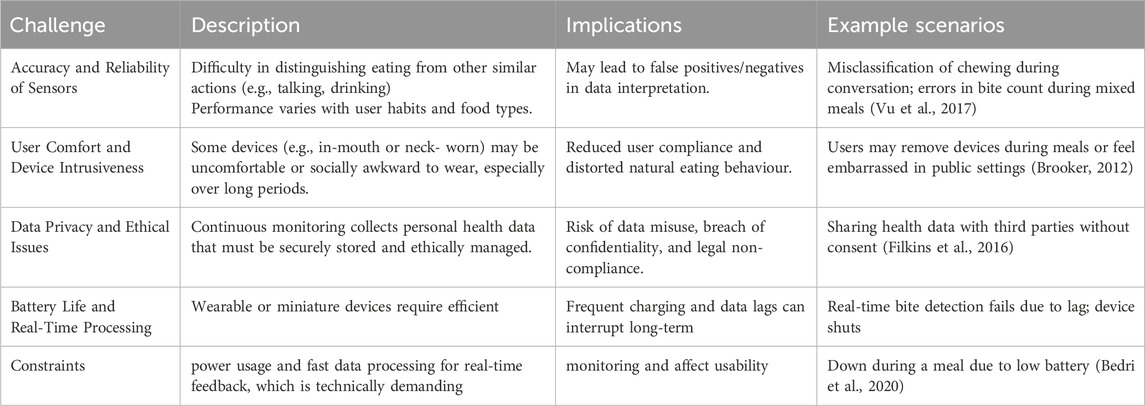- 1Institute of Biomechatronics, Makhachkala, Dagestan, Russia
- 2Department of Biotechnology, Era University, Lucknow, India
- 3Faculty of Computational Mathematics and Cybernetics, Lomonosov Moscow State University, Moscow, Russia
- 4Student Project Program, Biotechnology, Era University, Lucknow, India
- 5Department of pedodontics and preventive dentistry, career post graduate institute of dental sciences & hospital, Lucknow, India
- 6Higher School of Public Administration, Lomonosov Moscow State University, Moscow, Russia
- 7Chronobiology Unit, Department of Biotechnology, Era University, Lucknow, India
Monitoring eating behaviour is increasingly important in reducing morbidity and mortality from non-communicable diseases one of the risk factors for NCDs, such as cardiovascular diseases is a decrease in the ability to chew as people age. Research shows that increasing the quantity of chews during meals reduces food intake, promotes satiety, and maintains euglycemia. Despite these benefits, a significant portion of the population (64%–80%) does not monitor or pay attention to their chewing habits. This paper presents the development of a biomechatronic food intake monitoring system designed to track the thoroughness of chewing and determine the amount of food consumed. Using artificial intelligence the system can differentiate signals related to eating, such as jaw and head movements, from other movements, such as speaking. The aim of this paper is to review the importance of chewing for maintaining health, examine the relationship between chewing and NCDs, and present a technological solution for monitoring eating behaviour. We will explore the development of a biomechatronic system that helps users monitor their chewing habits, ensuring proper food intake and promoting healthy eating practices.
1 Introduction
The rising prevalence of non-communicable diseases (NCDs), such as cardiovascular diseases (CVD), obesity, and type 2 diabetes, is a pressing global health issue (Kuruvilla et al., 2023). These diseases are often linked to poor dietary habits and lifestyle choices, with eating behaviour playing a crucial role in their development (Kuruvilla et al., 2023). Among the various aspects of eating behaviour, chewing is not only a critical mechanical process for food breakdown but also plays a significant physiological role in swallowing, digestion, and nutritional regulation. Although literature suggests that impaired or enhanced chewing function may influence these processes, the overall strength of evidence remains limited (Kumar et al., 2022). Chewing capacity is a key determinant of an individual’s health status, particularly in relation to cardiovascular health. Research has shown that adults with preserved chewing capacity are more likely to maintain ideal cardiovascular health (CVH) behaviours, which include proper diet, regular physical activity, and avoiding smoking and excessive alcohol use. These individuals have a significantly lower risk of developing CVD and other related diseases compared to those with impaired chewing ability (Kumar et al., 2022; Iwasaki et al., 2018). Conversely, a decrease in chewing ability is associated with an increased risk of developing CVD as individuals age. For instance, studies indicate that the risk of developing CVD increases by a factor of 3.5 with age, particularly among individuals aged 50–64, whose chewing capacity is generally diminished compared to younger adults (Rangé et al., 2020; Schwahn et al., 2012; Aoyama et al., 2021). This decline in chewing ability is not only a result of aging but can also be exacerbated by conditions such as tooth loss, gum disease, and other oral health issues. Even in younger adults (aged 30–49), difficulties with chewing have been linked to a higher estimated risk of CVD, highlighting the critical role that chewing plays in cardiovascular health across the lifespan (Chun et al., 2022). Research has demonstrated that increasing the number of chews per bite has significant effects on food consumption and metabolic health. A key finding is that doubling the number of chews reduces the total volume of food consumed by approximately 14.8%, which can help reduce calorie intake and prevent overeating. This reduction in food intake is attributed to the extended time spent chewing, which slows down the eating process and provides the body with more time to signal feelings of fullness (Zhu and Hollis, 2014). Longer chewing times also promote satiety, which is essential for weight management and the prevention of obesity. As food is more thoroughly broken down in the mouth, the body is able to better regulate hunger signals, thereby reducing the risk of overeating and promoting better blood glucose control (Zhu and Hollis, 2014; Goh et al., 2021b). This connection between chewing and euglycemia is especially important for individuals at risk of developing type 2 diabetes, as slower, more deliberate eating can help manage insulin levels and reduce the likelihood of blood sugar spikes (Goh et al., 2021a).
Moreover, studies have shown that people who eat quickly tend to experience greater hunger later, driving them to consume more food. In contrast, those who eat slowly, requiring 42% more chews per bite, generally consume less food overall. This finding underscores the importance of not only the number of chews but also the timing and pacing of meals in regulating food intake (Goh et al., 2021b). The size of each bite and the duration of sensory exposure—such as the texture and taste of food also play critical roles in satiety. For the same number of calories consumed, individuals who take smaller bites and chew food longer tend to feel fuller for longer periods, helping to regulate their appetite and prevent excessive calorie consumption (Forde et al., 2013; Forde et al., 2017; Bolhuis et al., 2014). Additionally, altering food texture has been identified as an effective strategy for reducing calorie intake, as softer or more difficult-to-chew foods may lead individuals to chew longer, thus increasing the total number of chews and slowing down eating (Bolhuis et al., 2014). Despite the overwhelming evidence supporting the benefits of thorough chewing, a significant proportion of the population does not pay attention to this behaviour. Surveys and studies have indicated that between 65% and 80% of individuals across various age groups do not actively monitor the number of times they chew their food. Many people eat hastily due to time constraints or lack of awareness about the importance of chewing, which leads to a host of potential health issues, including overeating, digestive problems, and an increased risk of NCDs (Magomedova et al., 2021). This lack of awareness presents a significant public health challenge, as individuals are unlikely to address a behaviour they do not recognize as important. Therefore, finding innovative ways to monitor and encourage proper chewing is essential to improving public health and preventing the onset of NCDs (Ferrida et al., 2016).
In response to this issue, the development of wearable technologies that can monitor and provide feedback on chewing behaviour presents a promising solution. These technologies, such as biomechatronic systems for food intake monitoring, could help individuals become more aware of their eating habits, providing real-time feedback to encourage healthier chewing practices. Such devices could play a crucial role in addressing the growing burden of NCDs by promoting more mindful eating, thereby improving overall health and reducing the risk of chronic diseases.
In biomechatronic system, each sensor such as an EMG sensor detecting chewing or an inertial sensor monitoring jaw movement captures real-time physiological signals. These raw signals are first conditioned (e.g., amplified, filtered) and digitally converted. They are then transmitted to a central microcontroller via wired interfaces (e.g., ADC channels) or low-latency wireless links (e.g., Bluetooth Low Energy) for integration. Inside the microcontroller, the sensor data is continuously compared against predefined thresholds or a model of normative chewing behavior. When the system detects deviation such as chewing rate too high or low, the controller executes a feedback algorithm (akin to a PID or threshold-based control loop). It then sends precise command signals to the actuator module. Actuators whether vibrotactors, auditory beepers, or wearable haptics on the wrist, receive these commands and deliver real-time feedback to the user or downstream sensors. This completes a tightly coupled, closed-loop cycle: sensor → controller interpretation → actuator response. This loop enables instantaneous modulation of chewing behavior, enforcing timing, intensity, or pattern adjustments (Nicholls et al., 2019a).
2 Study selection methodology
We systematically searched peer-reviewed literature in PubMed, Scopus, IEEE Xplore, ScienceDirect, and Google Scholar. Search terms included combinations of “eating behavior,” “real-time monitoring,” “sensor,” “wearable,” along with synonyms and Boolean operators; keyword lists were refined through pilot searches. Inclusion criteria were: English-language studies involving employing automated, sensor-based systems to detect or modulate eating behaviors in real-world settings. Exclusion criteria encompassed qualitative or self-report methods, and studies lacking automated, real-time monitoring. We removed duplicates, then two independent reviewers screened titles and abstracts, followed by full-text assessment of eligible articles. Discrepancies were resolved by consensus. From each selected study, we extracted data on sensor modality, detection algorithm, evaluation environment, and performance metrics. These data were summarized in structured tables and discussed thematically to highlight technological trends, methodological strengths, and research gaps.
3 Eating behaviours and its significance
Eating behaviour is a complex and dynamic process influenced by both physiological and psychological factors. The physiological aspects of eating behaviour are primarily regulated by the central nervous system, particularly the hypothalamus, which controls hunger and satiety through various hormonal and neural signals. Key hormones involved in this regulation include ghrelin, which stimulates appetite, and leptin, which signals fullness to the brain. The digestive system, pancreas, and adipose tissue also play a crucial role in maintaining energy balance (Yeung and Tadi, 2025). Furthermore, the brain’s reward system, particularly the dopamine pathways, reinforces eating behaviours based on food palatability and emotional states. Metabolic processes such as glucose regulation, insulin sensitivity, and energy expenditure influence when and how much an individual eats. Disruptions in these physiological mechanisms can lead to irregular eating patterns, excessive food intake, or insufficient nourishment, ultimately impacting overall health (Lisco et al., 2023).
Beyond physiological regulation, psychological and environmental factors significantly shape eating behaviour. Emotional eating, driven by stress, anxiety, or depression, often leads individuals to consume high-calorie, comfort foods as a coping mechanism, reinforcing a cycle of unhealthy dietary choices. Social and cultural influences, including family traditions, peer pressure, and food marketing strategies, also impact eating habits. Cognitive factors, such as an individual’s beliefs about food, dieting behaviours, and body image perceptions, further contribute to how food is consumed and perceived. For instance, restrictive dieting can lead to binge eating episodes, while external cues such as portion sizes, food availability, and advertisements can encourage overeating. The interaction between physiological and psychological influences makes eating behaviour a critical determinant of health, requiring careful monitoring and intervention strategies to prevent long-term negative outcomes (Dakanalis et al., 2023).
Unhealthy eating behaviours have profound implications for overall wellbeing and can contribute to a range of chronic diseases. Metabolic disorders, including obesity and type 2 diabetes, are strongly linked to poor dietary habits such as excessive consumption of processed foods, high sugar intake, and irregular eating patterns. Overeating, particularly of high-fat and high-sugar foods, leads to weight gain and insulin resistance, increasing the risk of cardiovascular diseases, hypertension, and metabolic syndrome (Gropper, 2023).
Traditional methods of tracking food intake, such as self-reported food diaries and dietary recall surveys, are often unreliable due to memory biases, underreporting, and subjective errors. This limitation highlights the necessity of objective, technology-driven monitoring systems that can accurately assess eating patterns in real time. BiomechatronFEEic systems offer a revolutionary approach by integrating advanced sensor technology, artificial intelligence (AI), and real-time data analysis to track food intake, chewing patterns, and swallowing behaviours with high precision. Wearable devices equipped with electromyography (EMG), inertial measurement units (IMU), and acoustic sensors can detect jaw movements, bite frequency, and meal duration, providing an automated and accurate assessment of eating habits (Nicholls et al., 2022). Additionally, vision-based AI systems and smart utensils embedded with sensors can analyze food types, portion sizes, and nutritional composition. These technologies allow for the identification of unhealthy eating patterns, such as rapid eating, excessive snacking, or irregular meal consumption, which are associated with metabolic and digestive disorders (Figure 1). Shows the key factors affecting eating behaviour, including physiological processes (like hormones and brain signals), psychological and environmental influences (such as stress and social habits), and technological tools (like wearables and AI monitoring). These factors together impact overall health, including metabolic, cardiovascular, gastrointestinal, and mental wellbeing.
Monitoring eating behaviour is significant because it provides critical insights into an individual’s dietary patterns, enabling early detection of harmful habits that contribute to non-communicable diseases (NCDs). By continuously assessing how, when, and what people eat, monitoring systems can promote self-awareness, guide timely interventions, and support personalised nutritional strategies. This is particularly crucial in preventing lifestyle-related disorders such as obesity, diabetes, and heart disease. In clinical settings, real-time data fromeating behaviour monitoring can assist healthcare providers in diagnosing conditions like dysphagia, binge eating disorder, or malnutrition. Moreover, for elderly populations and individuals with cognitive impairments, these systems ensure adequate and safe nutrition, improving quality of life. As shown in (Table 1), the significance of monitoring extends beyond individual health, playing a vital role in public health management and technological innovation in healthcare.
4 Food intake mechanisms
To effectively choose the right types of sensors and determine where they should be placed on the body, it's important to first understand how food intake and digestion work. This section provides a simplified overview of the digestive process, focusing specifically on the parts that are most relevant to sensor placement and usage.
Digestion is generally divided into two main processes: mechanical digestion and chemical digestion. One example of chemical digestion is protein digestion, where the body breaks down dietary proteins into amino acids. These amino acids are then used for essential functions like maintaining muscles, supporting the immune system, synthesizing hormones, producing red blood cells, and repairing tissues (SF Gate, 2016). While there are commercial tools available such as the ITSI Biosciences protein digestion monitoring kit to track chemical digestion, wearable sensors currently play a limited role in this area (ITSI Biosciences, 2016).
This paper, therefore, places greater emphasis on mechanical digestion, as it involves physical actions like chewing and swallowing that can be more easily detected by sensors such as those based on vision, sound, and pressure.
4.1 Mechanisms of food intake
The process of food intake involves a series of intricately coordinated biomechanical and neuromuscular actions that enable the transport of food from the external environment to the stomach. This sequence begins with the act of biting, followed by chewing (mastication), and culminates in swallowing. Each stage engages distinct groups of muscles and joint movements, ranging from the fine motor control of the wrist and jaw to the reflexive contractions of the pharyngeal and esophageal muscles. These movements generate measurable physiological and biomechanical signals that reflect the dynamics of eating behaviour and can be captured using advanced sensing technologies (Figure 2). Illustrates the three fundamental stages involved in the mechanism of food intake: the bite mechanism, chewing (mastication), and swallowing. Each stage is visually represented alongside the key anatomical components responsible for the respective function. The bite mechanism highlights hand-to-mouth coordination and jaw activity; the chewing mechanism emphasizes the role of the masseter muscles in grinding food; and the swallowing mechanism outlines the pathway of the bolus from the oral cavity through the esophagus to the stomach. This sequential overview aids in understanding the biomechanical and physiological processes underlying human eating behaviour.
4.2 Bite mechanism
Taking a bite is the first step in the process of food intake. It mainly involves two actions: moving the wrist and hand to bring food to the mouth, and then using the jaw muscles to actually bite the food. Wrist movements are generally characterized by a rolling motion, known as pronation and supination, which helps in transferring food from cutlery to the mouth. Once the food reaches the mouth, jaw muscles take over. The lateral pterygoid muscle is responsible for opening the mouth (jaw abduction), while the temporalis, masseter, and medial pterygoid muscles help close the mouth and perform side-to-side grinding movements (Muscles Used, 2016).
4.3 Chewing (mastication) mechanism
Mechanical digestion involves physically breaking down food, starting in the mouth and continuing through the pharynx and esophagus. It begins with chewing, or mastication, where food is crushed and ground to form a soft mass called a bolus, which can then be swallowed. During this phase, food is moved from the front of the mouth to the back teeth for grinding. The jaw muscles used during chewing are similar to those used in biting, with coordinated movements from the lateral pterygoid and temporalis muscles to repeatedly open and close the mouth (Panara et al., 2025).
4.4 Swallowing mechanism
Swallowing happens in three stages. It starts with a voluntary phase, where the tongue folds and manipulates the chewed food (bolus), pushing it to the back of the mouth in preparation for swallowing. Next comes the involuntary pharyngeal phase, where the swallowing reflex activates. The upper esophageal sphincter opens, and pharyngeal constrictor muscles push the bolus downward through a stripping motion. In the final esophageal phase, which is also involuntary, a wave-like motion called peristalsis moves the bolus down the esophagus. This involves the sequential contraction of the superior, middle, and inferior esophageal muscles, eventually delivering the bolus to the stomach (Panara et al., 2025).
The coordinated muscle activities involved in chewing and swallowing, spanning the oral cavity, pharynx, and esophagus and generate distinct biomechanical and physiological signals. These signal patterns, which reflect the dynamic processes of food intake, can be effectively captured and analyzed using various wearable sensor technologies.
5 Fundamentals of biomechatronic systems
Biomechatronics is a highly interdisciplinary field that merges principles from biology, mechanical engineering, electronics, and computational intelligence to design and develop advanced systems capable of interacting with and augmenting biological organisms, particularly humans. This integration allows for the creation of sophisticated devices and interfaces such as prosthetics, orthotics, exoskeletons, neural interfaces, and wearable health monitors that seamlessly combine artificial components with the human body. The central aim of biomechatronics is to enhance, restore, or even replace impaired physiological functions, thereby improving the quality of life for individuals with disabilities or medical conditions. By leveraging cutting-edge technologies like artificial intelligence, biosensors, actuators, and embedded systems, biomechatronic systems can provide real-time feedback, adaptive responses, and personalized support that mimics or complements natural biological processes (Metan et al., 2014). (Figure 3) Illustrates the essential components of a biomechatronic system and their interaction. The system integrates four main elements: the biological subsystem, which includes the human body’s physiological structure; actuators, which execute physical actions in response to control signals; control systems and data processing, which interpret sensor data and coordinate appropriate responses; and sensors, which collect real-time biological and environmental data. These components work in a continuous feedback loop to enable effective human-machine interaction and support or restore physiological functions.
The key components of a biomechatronic system include
5.1 Biological system (Human-technology interface)
The biological system serves as the core interface in any biomechatronic framework, enabling the interaction between human physiology and engineered technological components. In the context of monitoring eating behaviour, it is crucial to understand the anatomical structures, physiological processes, and neuromuscular coordination involved in the act of food consumption. The primary biological structures implicated in this process include the mouth, jaw, tongue, teeth, lips, throat (pharynx), esophagus, and hands. Each of these components plays a specialized role in the sequential phases of eating, namely, prehension (food grasping), mastication (chewing), gustation (taste processing), deglutition (swallowing), and hand to mouth coordination (Chen, 2009). (Figure 4) illustrates the biological system as a human–technology interface in biomechatronic eating behaviour monitoring. It highlights key body parts such as lips, jaw, tongue, pharynx, esophagus, and hands which are involved in eating, along with the sensor technologies used to monitor their activity. Each component is linked to specific phases of eating (prehension, mastication, gustation, deglutition, conveyance) and is tracked using tools like EMG, accelerometers, intraoral sensors, bioimpedance, and cameras. The integration of these technologies enables precise and real-time tracking of eating behaviour for health monitoring and intervention.
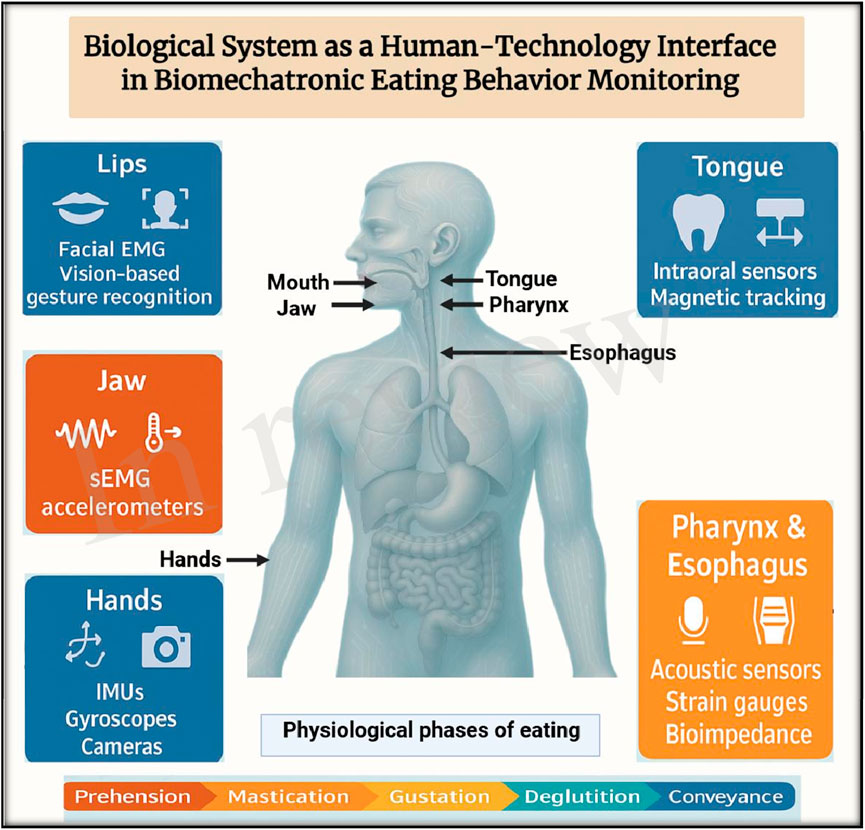
Figure 4. Biological components and sensor integration in biomechatronic eating behavior monitoring.
The jaw and masticatory muscles (such as the masseter, temporalis, and pterygoids) are responsible for the mechanical breakdown of food, producing measurable biomechanical signals such as pressure, muscle contractions, and vibrations (Chen, 2009). These signals are often exploited by biomechatronic systems using surface electromyography (sEMG) or accelerometers for detecting chewing events (Abu et al., 2023). The tongue, with its intrinsic and extrinsic muscles, assists in food manipulation, bolus formation, and propulsion toward the pharynx, while also playing a critical role in taste perception. Monitoring tongue motion is a complex task but is increasingly being explored through intraoral sensors and magnet tracking systems (Ross et al., 2024). The pharynx and upper esophageal sphincter are involved in the voluntary and reflexive phases of swallowing, which can be detected through acoustic sensors, strain gauges, or bioimpedance measurements. Swallowing is a rapid and complex process regulated by central pattern generators in the brainstem, making it a reliable physiological marker in biomechatronic detection systems. Lip and facial muscle movements, regulated by the facial nerve, also contribute to food intake and are being increasingly used for gesture recognition in eating detection (Ross et al., 2024). Furthermore, the hands and upper limbs facilitate food handling and conveyance to the mouth, with motion captured through inertial measurement units (IMUs), gyroscopes, or vision-based systems. These gestures are often used to differentiate between eating and non-eating activities in real-world monitoring scenarios (Heydarian et al., 2019).
An in-depth understanding of the neuromuscular coordination, biomechanical dynamics, and sensorimotor control underlying these biological functions is fundamental for the development of accurate and non-intrusive biomechatronic systems. Such understanding allows researchers and engineers to strategically position sensors, interpret physiological signals correctly, and minimize false positives from confounding behaviours like speaking or drinking. Ultimately, the biological system not only serves as the source of measurable signals but also defines the functional constraints and design considerations for any human-centered eating behaviour monitoring device. Bridging biological complexity with technological innovation is therefore central to the success of biomechatronic interventions aimed at health monitoring, nutrition tracking, and behavioural analysis.
5.1.1 Mouth and jaw movement
The jaw is a complex structure controlled by the temporomandibular joint (TMJ) and various muscles, including the masseter, temporalis, and pterygoid muscles. These muscles facilitate different types of chewing motions, such as vertical (up-down), lateral (side-to-side), and rotary movements. Biomechatronic systems often use inertial sensors, electromyography (EMG), and strain sensors to capture jaw kinematics and assess chewing efficiency, force, and frequency (Abu et al., 2023; Murray, 2016).
5.1.2 Tongue dynamics in food manipulation
The tongue plays a crucial role in repositioning food within the oral cavity, ensuring proper mastication and preparing the food bolus for swallowing. It is a highly flexible muscular organ controlled by intrinsic and extrinsic muscles that allow precise movements. The tongue’s motion is often monitored using electromyography (EMG) sensors, pressure-sensitive devices, and optical tracking to detect anomalies in food manipulation, which can be useful in diagnosing dysphagia (swallowing disorders) and neuromuscular conditions like Parkinson’s disease (Schwahn et al., 2012).
5.1.3 Throat and swallowing mechanism
Swallowing, or deglutition, is a complex process involving three phases: oral, pharyngeal, and esophageal. It requires the coordinated movement of the tongue, soft palate, pharyngeal muscles, and esophageal sphincters. Disruptions in swallowing mechanics can lead to aspiration, choking, or malnutrition, particularly in individuals with neurological disorders. Biomechatronic systems utilize acoustic sensors, piezoelectric transducers, and high-resolution impedance sensors placed on the throat to track swallowing events, bolus transit time, and airway protection mechanisms (Abu et al., 2023; Ross et al., 2024).
5.1.4 Hand and arm movements in food intake
Beyond oral activity, hand movements play a crucial role in bringing food to the mouth. The coordination between the fingers, wrist, and forearm determines eating efficiency, particularly in individuals with motor impairments (e.g., stroke, cerebral palsy, or Parkinson’s disease). Advanced biomechatronic systems incorporate inertial measurement units (IMUs), computer vision, and motion capture technology to assess hand tremors, grip strength, and movement patterns while eating. Smart utensils with adaptive grip control and haptic feedback can assist individuals with limited dexterity (Heydarian et al., 2019).
5.2 Sensors for data acquisition
Sensors form the backbone of biomechatronic systems, enabling the real-time acquisition of physiological and behavioural data essential for monitoring human activities with precision. In the domain of eating behaviour monitoring, sensors play a pivotal role by capturing a wide range of measurable parameters including jaw motion, muscle activation patterns, swallowing events, food intake duration, and hand-to-mouth gestures. These data points are critical not only for analysing normal eating patterns but also for detecting anomalies associated with disorders such as dysphagia, binge eating, and obesity (Heydarian et al., 2019). A diverse array of sensor technologies is employed in these systems, including surface electromyography (sEMG) for measuring masticatory muscle activity, accelerometers and gyroscopes for tracking head or hand movements, acoustic sensors for detecting swallowing sounds, and strain gauges or piezoelectric sensors for capturing bite forces. Vision-based systems and inertial measurement units (IMUs) are also used for gesture recognition during food intake. By integrating these sensors into wearable or embedded platforms, biomechatronic systems can deliver continuous, non-invasive, and context-aware monitoring. Shajari et al. conducted a comprehensive review on AI-based wearable sensors, emphasizing their growing role in dietary assessment and real-time behavior tracking. These intelligent systems adapt to user-specific patterns, enhancing accuracy and personalization in eating behavior monitoring (Shajari et al., 2023). Despite these challenges, in-mouth sensors hold significant promise for applications requiring fine-grained data. This has significant implications for diagnostic support, behavioural intervention, and the development of assistive technologies for individuals with physical or neurological impairments affecting eating behaviour, thus advancing personalized healthcare and nutritional therapy (ITSI Biosciences, 2016; Abu et al., 2023). (Figure 5) Presents different wearable and embedded sensors used to monitor human ingestion activity. EMG sensors track muscle activity and chewing via the jaw, while IMUs detect jaw motion and gestures. Acoustic sensors capture swallowing and chewing sounds, and optical sensors visually monitor bite size and eating gestures. Biosensors, placed in the mouth, analyze saliva for hormones and glucose, offering a complete picture of eating behaviour (Sazonov and Fontana, 2012).
5.3 Actuators for biomechanical response
Actuators play a crucial role in biomechatronic systems by enabling physical interactions and feedback mechanisms based on sensor data. While actuators are commonly associated with prosthetics, exoskeletons, and rehabilitation devices, they are also highly relevant in eating behaviours monitoring. In this context, actuators can provide real-time feedback, assist individuals with motor impairments, and regulate feeding patterns to promote healthier eating behaviours (Preethichandra et al., 2024).
Actuators in biomechatronic systems function as output devices that convert electrical signals into mechanical motion, vibrations, or other responses. These responses can be haptic (touch-based), electrical, or mechanical, depending on the application. The two key types of actuators used in eating behaviours monitoring include haptic feedback actuators and smart prosthetic and assistive devices (Figure 6). Presents a flowchart that categorizes the two primary types of actuators used in biomechatronic systems for eating behaviour monitoring: haptic feedback actuators and smart prosthetics and assistive devices. These actuators form a feedback-driven system that enhances eating safety, promotes mindful consumption, and supports rehabilitation efforts.
5.3.1 Haptic feedback actuators
Haptic feedback actuators are tactile interface devices that deliver vibrational or electrical stimuli to users based on sensor-detected behavioural or physiological inputs (Engineering Product Design, 2024). In biomechatronic systems for eating behaviour monitoring, these actuators play a vital role by providing real-time, non-visual cues to guide and correct user actions. Commonly embedded in wearable devices such as smartwatches, rings, headbands, and even in smart utensils or intraoral appliances, haptic actuators are particularly effective in promoting healthy and safe eating practices. One of their primary applications is regulating eating speed, a crucial factor in managing obesity, binge eating, and metabolic disorders such as diabetes. For instance, wristbands or utensils equipped with haptic actuators can vibrate to alert users when they are eating too rapidly, encouraging mindful, paced consumption. In individuals with dysphagia, post-stroke conditions, or elderly populations, haptic feedback can also serve as a choking prevention tool, reminding users to take smaller bites or chew more thoroughly when sensors detect irregular swallowing patterns. Nicholls et al. (2022) introduced an advanced EMG-based wearable system for detecting chewing activity in real time. The system incorporates haptic feedback to alert users during rapid eating, promoting mindful chewing patterns. This closed-loop approach not only improves behavioral awareness but also has potential for therapeutic use in obesity and binge eating disorders (Nicholls et al., 2022). Furthermore, haptic devices can be used to enhance postural control during eating, especially for individuals with neuromuscular disorders like Parkinson’s disease or cerebral palsy, by gently reminding them to maintain proper head and neck alignment. Additionally, these actuators are increasingly employed in neuromuscular rehabilitation and therapy, providing biofeedback during chewing and swallowing exercises for patients with conditions such as ALS, multiple sclerosis, or those recovering from stroke. By translating sensor data into tactile signals, haptic feedback systems create a closed-loop interaction between the user and device, fostering improved awareness, safety, and behavioural modification in eating practices (Nicholls et al., 2019b; Brooker, 2012).
5.3.2 Smart prosthetics and assistive devices
Assistive technologies and smart prostheses are increasingly being developed to monitor and support vital behaviours like feeding habits in addition to helping to recover motor function. In order to identify physiological signals and help users with everyday tasks, these systems integrate sensors, actuators, and control systems using biomechatronic principles. An EMG-based wearable gadget, for example, has a classification accuracy of more than 95% in identifying eating events and tracks chewing and swallowing activities while providing real-time haptic feedback to encourage mindful eating (Nicholls et al., 2019c). A wearable gadget called the Automatic Ingestion Monitor (AIM), which combines accelerometer, hand gesture, and jaw motion sensors, was also demonstrated to have an accuracy of 89.8% in identifying food intake events in free-living environments (Dong et al., 2012). Also, the SPLENDID eating detection sensor uses both optical and audio sensors to track eating and provide real-time feedback through a mobile app (Thomaz et al., 2015).
6 Types of Biomechatronic Devices for Eating Monitoring
Advancements in biomechatronics have led to the development of diverse devices designed to monitor and analyze eating behaviour with precision and minimal intrusion. These devices integrate sensors, actuators, and intelligent algorithms to capture key physiological and behavioural parameters related to food intake. Depending on the application context, ranging from clinical interventions to lifestyle monitoring, these technologies can be worn on the body, embedded in utensils, or even placed inside the mouth (Figure 7). Shows four major categories of biomechatronic devices used to monitor eating behaviour: Wearable Devices, In-Ear and Neck-Worn Systems, Smart Utensils, and In-Mouth Sensors or Dental-Mounted Devices. Each category is represented with its primary function. These devices, through sensor integration and real-time data analysis, offer valuable tools for dietary monitoring, behavioural interventions, and clinical assessments in both research and real-world settings.
6.1 Wearable devices
Wearable devices have become increasingly popular in biomechatronic applications due to their non-invasive nature, user-friendliness, and ability to provide continuous monitoring. In the context of eating behaviour, wearables such as smartwatches, wristbands, and e-textiles can detect hand-to-mouth gestures, wrist motion patterns, and arm movements associated with food intake. These devices are often embedded with accelerometers, gyroscopes, and magnetometers that capture motion data, which can then be analysed to infer bite count, meal duration, and eating speed. A recent study by Ghosh et al. combined visual input with sensor-based motion tracking to detect eating events in free-living environments. Their system achieved high accuracy even in non-laboratory conditions, addressing a key challenge in ecological validity of wearable-based monitoring systems (Ghosh et al., 2024). E-textiles, which integrate conductive fibres and sensors into clothing, offer the advantage of seamless and discreet monitoring. These smart garments can track muscular activity and posture changes during meals, providing valuable insights without disrupting normal eating routines. Overall, wearable technologies serve as practical tools for unobtrusive, long-term monitoring of dietary habits in real-world settings (Vu et al., 2017).
6.2 In-ear and neck-worn systems
In-ear and neck-worn devices represent another innovative category in biomechatronic systems for monitoring eating behaviour. These devices typically leverage acoustic sensors, microphones, or piezoelectric elements to detect chewing, swallowing, and jaw motion. In- ear devices are advantageous due to their proximity to the temporomandibular joint, where mechanical vibrations from chewing are prominent. By capturing these signals, they can reliably quantify chewing frequency, duration, and intensity. Neck-worn systems, such as collar-like wearables or adhesive patches on the neck region, monitor swallowing activity using sensors that detect laryngeal movement or throat vibrations. The FitByte system by Bedri et al. (2020) exemplifies a multimodal sensing approach, using eyeglasses embedded with acoustic and motion sensors to unobtrusively track food intake. This wearable solution supports hands-free monitoring and may be particularly beneficial for elderly users or individuals with motor impairments (Bedri et al., 2020). These systems are especially useful in studying conditions like dysphagia or abnormal swallowing patterns. Despite their effectiveness, challenges such as maintaining user comfort and minimizing signal interference from speaking or head movement remain areas of active research and development (Vu et al., 2017).
6.3 Smart utensils (e.g., Forks, Spoons)
Smart utensils are specially designed eating tools embedded with sensors and electronics to monitor food intake directly. These utensils are capable of tracking parameters like the number of bites, the interval between bites, and the duration of meals. Some advanced versions even include feedback mechanisms such as vibration alerts to encourage mindful eating and slow down eating speed. Smart utensils provide a direct and intuitive approach to monitoring eating behaviour and are particularly useful for behavioural interventions in weight management and obesity treatment. Their user-centric design enhances acceptability, especially in clinical or home-based settings. However, their utility may be limited to certain environments (e.g., structured meals) and food types, and may not capture snacking or finger-food consumption effectively (Huang et al., 2018).
6.4 In-mouth sensors or dental-mounted devices
In-mouth biomechatronic devices represent the most direct and precise method of monitoring eating behaviours. These systems are typically miniaturized and embedded within dental appliances, retainers, or mounted directly on teeth. Equipped with sensors such as piezoelectric elements, pressure sensors, or accelerometers, they are capable of detecting chewing cycles, bite force, and tongue movement with high fidelity. Dental-mounted devices offer unparalleled proximity to the food-mastication interface, resulting in highly accurate data on chewing frequency and food texture. However, issues such as comfort, hygiene, battery limitations, and user acceptability need to be addressed before these technologies can be widely adopted. Despite these challenges, in-mouth sensors hold significant promise for applications requiring fine-grained data, such as clinical research in eating disorders or rehabilitation in patients with impaired oral-motor function (Vu et al., 2017).
7 Challenges and limitations
Despite the rapid advancements in biomechatronic systems for monitoring eating behaviour, several challenges and limitations hinder their widespread adoption and real-world implementation. One of the most critical issues is the accuracy and reliability of sensors, as eating involves complex, dynamic movements that can be difficult to distinguish from other similar body activities like speaking or coughing. Moreover, these systems must be reliable across different users, food types, and environmental conditions. Another significant concern is user comfort and device intrusiveness, particularly for in-ear or in-mouth systems, which may affect natural eating behaviour due to discomfort or self-consciousness. Additionally, the increasing use of personal health data raises serious data privacy and ethical issues. The collection and transmission of sensitive eating behaviour data must comply with strict privacy regulations and ethical standards. Finally, battery life and real-time processing constraints remain technical limitations, especially for wearable and implantable systems that require constant operation without frequent recharging. These challenges must be addressed to develop robust, user-friendly, and clinically effective biomechatronic solutions for eating behaviour monitoring (Vu et al., 2017) (Table 2). Outlines the key challenges and limitations associated with biomechatronic systems for monitoring eating behaviours. These include issues with sensor accuracy, user comfort, data privacy, and technical constraints such as battery life and real-time processing. Each of these factors can impact the system’s effectiveness, user compliance, and long-term usability, highlighting the need for continued innovation and ethical considerations in system design.
8 Conclusion
In today’s world, where lifestyle-related health problems like obesity, diabetes, and heart disease are on the rise, monitoring how and what we eat has become more important than ever. Eating behaviour is not just about choosing what’s on our plate it’s influenced by a mix of biological signals from our brain and hormones, emotional states like stress or anxiety, and even social factors like culture or peer pressure. When these influences go off balance, they can lead to unhealthy eating patterns such as overeating, emotional eating, or irregular meals, all of which can seriously affect our health in the long run. This review has explored how biomechatronic systems, devices that combine biology, mechanics, and electronics are changing the way we monitor eating behaviour. These advanced systems use sensors and artificial intelligence to track jaw movements, chewing, bite counts, and even the types and amounts of food consumed. Unlike traditional food diaries, which depend on memory and self-reporting, biomechatronic systems provide real-time, objective, and accurate data. This can be a game-changer not only for individuals trying to improve their eating habits but also for doctors and caregivers managing patients with dietary concerns or swallowing difficulties. However, as promising as these systems are, they are not without their challenges. Issues such as discomfort while wearing the device, difficulty in distinguishing eating from other activities like talking, concerns about data privacy, and limitations in battery life still need to be addressed. Improving these areas will be key to making the technology more user-friendly and effective for everyday use. Monitoring eating behaviour using biomechatronic systems offers a powerful new tool to support healthier lifestyles. With continued research and development, these systems have the potential to not only enhance personal health awareness but also support clinical practices, nutritional planning, and even elderly care. They represent an exciting step forward in using technology to make better health decisions starting with something as simple and essential as how we eat.
Author contributions
MM: Supervision, Writing – review and editing, Writing – original draft, Conceptualization, Data curation, Investigation. SK: Validation, Visualization, Writing – original draft, Investigation. AlM: Investigation, Methodology, Data curation, Software, Writing – review and editing, Conceptualization, Validation. FF: Writing – review and editing. AM: Project administration, Writing – review and editing, Methodology, Investigation, Resources. SP: Writing – review and editing, Investigation, Resources, Project administration, Methodology. AmM: Project administration, Methodology, Writing – review and editing, Investigation, Resources. GF: Visualization, Software, Formal Analysis, Project administration, Resources, Data curation, Writing – original draft, Validation, Conceptualization, Writing – review and editing, Funding acquisition, Supervision, Methodology, Investigation.
Funding
The author(s) declare that no financial support was received for the research and/or publication of this article.
Acknowledgments
We greatly acknowledge Era University for logistic help.
Conflict of interest
The authors declare that the research was conducted in the absence of any commercial or financial relationships that could be construed as a potential conflict of interest.
Generative AI statement
The author(s) declare that no Generative AI was used in the creation of this manuscript.
Publisher’s note
All claims expressed in this article are solely those of the authors and do not necessarily represent those of their affiliated organizations, or those of the publisher, the editors and the reviewers. Any product that may be evaluated in this article, or claim that may be made by its manufacturer, is not guaranteed or endorsed by the publisher.
References
Abu, O. H., Owida, H. A., De Fazio, R., Al-Naami, B., and Visconti, P. (2023). Electromyography monitoring systems in rehabilitation: a review of clinical applications, wearable devices and signal acquisition methodologies. Electronics 12 (7), 1520. doi:10.3390/electronics12071520
Ahuja, A., Pelton, M., Raval, S., and Kesavarapu, K. (2023). Role of nutrition in gastroesophageal reflux, irritable bowel syndrome, celiac disease, and inflammatory bowel disease. Gastro Hep Adv. 2 (6), 860–872. doi:10.1016/j.gastha.2023.06.010
Aoyama, N., Fujii, T., Kida, S., Nozawa, I., Taniguchi, K., Fujiwara, M., et al. (2021). Association of periodontal status, number of teeth, and obesity: a cross-sectional study in Japan. J. Clin. Med. 10 (2), 208. doi:10.3390/jcm10020208
Bedri, A., Li, D., Khurana, R., Bhuwalka, K., and Goel, M. (2020). “FitByte: automatic diet monitoring in unconstrained situations using multimodal sensing on eyeglasses,” in Proceedings of the 2020 CHI Conference on Human Factors in Computing Systems, Honolulu, HI, USA, April 25-30, 2020, 1–13.
Bolhuis, D. P., Forde, C. G., Cheng, Y., Xu, H., Martin, N., and de Graaf, C. (2014). Slow food: sustained impact of harder foods on the reduction in energy intake over the course of the day. PLoS One 9 (4), e93370. doi:10.1371/journal.pone.0093370
Chen, J. (2009). Food oral processing—A review. Food Hydrocoll. 23 (1), 1–25. doi:10.1016/j.foodhyd.2007.11.013
Chun, H., Oh, J., and Doo, M. (2022). The risk of cardiovascular disease according to chewing status could be modulated by healthy diet in middle-aged koreans. Nutrients 14 (18), 3849. doi:10.3390/nu14183849
Dakanalis, A., Mentzelou, M., Papadopoulou, S. K., Papandreou, D., Spanoudaki, M., Vasios, G. K., et al. (2023). The association of emotional eating with overweight/obesity, depression, anxiety/stress, and dietary patterns: a review of the current clinical evidence. Nutrients 15 (5), 1173. doi:10.3390/nu15051173
Dong, Y., Hoover, A., Scisco, J., and Muth, E. (2012). A new method for measuring meal intake in humans via automated wrist motion tracking. Appl. Psychophysiol. Biofeedback 37 (3), 205–215. doi:10.1007/s10484-012-9194-1
Engineering Product Design (2024). What are haptic feedback and actuators? Available online at: https://engineeringproductdesign.com/knowledge-base/haptic-feedback-and-technology/(Accessed April 16, 2025).
Ferriday, D., Bosworth, M. L., Godinot, N., Martin, N., Forde, C. G., Van Den Heuvel, E., et al. (2016). Variation in the oral processing of everyday meals is associated with fullness and meal size; a potential nudge to reduce energy intake? Nutrients 8 (5), 315. doi:10.3390/nu8050315
Filkins, B. L., Kim, J. Y., Roberts, B., Barrett, K. A., Canfield, D., Frankel, T. L., et al. (2016). Privacy and security in the era of digital health: what should translational researchers know and do about it? Am. J. Transl. Res. 8 (3), 1560–1580.
Forde, C. G., Leong, C., Chia-Ming, E., and McCrickerd, K. (2017). Fast or slow-foods? Describing natural variations in oral processing characteristics across a wide range of Asian foods. Food Funct. 8 (2), 595–606. doi:10.1039/c6fo01286h
Forde, C. G., van Kuijk, N., Thaler, T., de Graaf, C., and Martin, N. (2013). Oral processing characteristics of solid savoury meal components, and relationship with food composition, sensory attributes and expected satiation. Appetite 60 (1), 208–219. doi:10.1016/j.appet.2012.09.015
Ghosh, T., Han, Y., Raju, V., Hossain, D., McCrory, M. A., Higgins, J., et al. (2024). Integrated image and sensor-based food intake detection in free-living. Sci. Rep. 14, 1665. doi:10.1038/s41598-024-51687-3
Goh, A. T., Chatonidi, G., Choy, M., Ponnalagu, S., Stieger, M., and Forde, C. G. (2021a). Impact of individual differences in eating rate on oral processing, bolus properties and post-meal glucose responses. Physiol. Behav. 238, 113495. doi:10.1016/j.physbeh.2021.113495
Goh, A. T., Choy, J. Y. M., Chua, X. H., Ponnalagu, S., Khoo, C. M., Whitton, C., et al. (2021b). Increased oral processing and a slower eating rate increase glycaemic, insulin and satiety responses to a mixed meal tolerance test. Eur. J. Nutr. 60 (5), 2719–2733. doi:10.1007/s00394-020-02466-z
Gropper, S. S. (2023). The role of nutrition in chronic disease. Nutrients 15 (3), 664. doi:10.3390/nu15030664
Heydarian, H., Adam, M., Burrows, T., Collins, C., and Rollo, M. E. (2019). Assessing eating behaviour using upper limb mounted motion sensors: a systematic review. Nutrients 11 (5), 1168. doi:10.3390/nu11051168
Huang, Q., Yang, Z., and Zhang, Q. (2018). “Smart-U: Smart utensils know what you eat,” in IEEE INFOCOM 2018 - IEEE Conference on Computer Communications, Honolulu, HI, USA, 2018 Apr 15–19 (IEEE), 1439–1447.
ITSI Biosciences (2016). Protein digestion monitoring kit. Available online at: http://www.itsibio.com/prodm.html (Accessed December 30, 2016).
Iwasaki, T., Fukuda, H., Kitamura, M., Kawashita, Y., Hayashida, H., Furugen, R., et al. (2018). Association between number of pairs of opposing posterior teeth, metabolic syndrome, and obesity. Odontology 107 (1), 111–117. doi:10.1007/s10266-018-0386-x
Kumar, A., Almotairy, N., Merzo, J. J., Wendin, K., Rothenberg, E., Grigoriadis, A., et al. (2022). Chewing and its influence on swallowing, gastrointestinal and nutrition-related factors: a systematic review. Crit. Rev. Food Sci. Nutr. 63 (33), 11987–12017. doi:10.1080/10408398.2022.2098245
Kuruvilla, A., Mishra, S., and Ghosh, K. (2023). Prevalence and risk factors associated with non-communicable diseases among employees in a university setting: a cross-sectional study. Clin. Epidemiol. Glob. Health 21, 101282. doi:10.1016/j.cegh.2023.101282
Lisco, G., De Tullio, A., Iovino, M., Disoteo, O., Guastamacchia, E., Giagulli, V. A., et al. (2023). Dopamine in the regulation of glucose homeostasis, pathogenesis of type 2 diabetes, and chronic conditions of impaired dopamine activity/metabolism: implication for pathophysiological and therapeutic purposes. Biomedicines 11 (11), 2993. doi:10.3390/biomedicines11112993
Liu, J., Lu, W., Lv, Q., Wang, Y., Xu, X., He, Y., et al. (2024). Impact of dietary patterns on metabolic syndrome in young adults: a cross-sectional study. Nutrients 16 (17), 2890. doi:10.3390/nu16172890
Magomedova, A. G., Singh, R. B., and Horuichi, R. (2021). Regional differences in chronobiological behavioural factors among school children in the Russian Federation. World Heart J. 13 (1), 269–272.
Mars, J. A., Iqbal, A., and Rehman, A. (2025). Binge eating disorder. Treasure Island (FL): StatPearls Publishing.
Mazur, M., Przytuła, A., Szymańska, M., and Popiołek-Kalisz, J. (2024). Dietary strategies for cardiovascular disease risk factors prevention. Curr. Probl. Cardiol. 49 (9), 102746. doi:10.1016/j.cpcardiol.2024.102746
Metan, S., Bhandari, R., Dafedar, A., Bangartale, V., and Ande, P. (2014). Advances and development in biomechatronics – introduction to arm prosthesis. Int. J. Electron Commun. Eng. Technol. 5 (10), 45–54. Available online at: http://www.iaeme.com/IJECET.asp.
Murray, G. M. (2016). “Jaw movement and its control,” in Functional occlusion in restorative dentistry and prosthodontics (Elsevier), 55–66. doi:10.1016/B978-0-7234-3809-0.00005-X
Muscles Used (2016). Muscles of mastication. Available online at: http://www.musclesused.com/muscles-mastication-chewin/(Accessed December 30, 2016).
National Institute for Health and Care Excellence (2020). Eating disorders: recognition and treatment. London: National Institute for Health and Care Excellence.
Nicholls, B., Ang, C. S., Kanjo, E., Siriaraya, P., Mirzaee Bafti, S., Yeo, W. H., et al. (2022). An EMG-based eating behaviour monitoring system with haptic feedback to promote mindful eating. Comput. Biol. Med. 149, 106068. doi:10.1016/j.compbiomed.2022.106068
Nicholls, B., Ang, C. S., Kanjo, E., Siriaraya, P., Yeo, W., and Tsanas, A. (2019a). An EMG-Based eating behaviour monitoring system with haptic feedback to promote mindful eating. Cornell University. arXiv. doi:10.48550/arxiv.1907.10917
Nicholls, B., Ang, C. S., Kanjo, E., Siriaraya, P., Yeo, W.-H., and Tsanas, A. (2019b). An EMG-Based eating behaviour monitoring system with haptic feedback to promote mindful eating. Available online at: https://arxiv.org/abs/1907.10917 (Accessed April 16, 2025).
Nicholls, B., Ang, C. S., Kanjo, E., Siriaraya, P., Yeo, W.-H., and Tsanas, A. (2019c). An EMG-Based eating behaviour monitoring system with haptic feedback to promote mindful eating. arXiv preprint arXiv:1907.10917.
Panara, K., Ramezanpour Ahangar, E., and Padalia, D. (2025). “Physiology, swallowing,” in StatPearls (Treasure Island (FL): StatPearls Publishing).
Preethichandra, D. M. G., Piyathilaka, L., Sul, J. H., Izhar, U., Samarasinghe, R., Arachchige, S. D., et al. (2024). Passive and active exoskeleton solutions: sensors, actuators, applications, and recent trends. Sensors (Basel) 24 (21), 7095. doi:10.3390/s24217095
Rangé, H., Perier, M.-C., Boillot, A., Offredo, L., Lisan, Q., Guibout, C., et al. (2020). Chewing capacity and ideal cardiovascular health in adulthood: a cross-sectional analysis of a population-based cohort study. Clin. Nutr. 39 (5), 1440–1446. doi:10.1016/j.clnu.2019.05.029
Robinson, S. M. (2018). Improving nutrition to support healthy ageing: what are the opportunities for intervention? Proc. Nutr. Soc. 77 (3), 257–264. doi:10.1017/S0029665117004037
Ross, C. F., Laurence-Chasen, J. D., Li, P., Orsbon, C., and Hatsopoulos, N. G. (2024). Biomechanical and cortical control of tongue movements during chewing and swallowing. Dysphagia 39 (1), 1–32. doi:10.1007/s00455-023-10596-9
Sazonov, E., and Fontana, J. M. (2012). A sensor system for automatic detection of food intake through non-invasive monitoring of chewing. IEEE Sens. J. 12 (5), 1340–1348. doi:10.1109/JSEN.2011.2172411
Schwahn, C., Polzer, I., Haring, R., Dörr, M., Wallaschofski, H., Kocher, T., et al. (2012). Missing, unreplaced teeth and risk of all-cause and cardiovascular mortality. Int. J. Cardiol. 167 (4), 1430–1437. doi:10.1016/j.ijcard.2012.04.061
SF Gate (2016). Protein digestion inside the human body. Available online at: http://healthyeating.sfgate.com/protein-digestion-inside-human-body-6044.html (Accessed December 30, 2016).
Shajari, S., Kuruvinashetti, K., Komeili, A., and Sundararaj, U. (2023). The emergence of AI-based wearable sensors for digital health technology: a review. Sensors (Basel) 23 (23), 9498. doi:10.3390/s23239498
Theodore, A. T. P., Nfor, K. A., Kim, J. I., and Kim, H. C. (2024). Applications of artificial intelligence, machine learning, and deep learning in nutrition: a systematic review. Nutrients 16 (7), 1073. doi:10.3390/nu16071073
Thomaz, E., Essa, I., and Abowd, G. D. (2015). “A practical approach for recognizing eating moments with wrist-mounted inertial sensing,” in Proceedings of the 2015 ACM International Joint Conference on Pervasive and Ubiquitous Computing, Osaka, Japan, September 7-11, 2015, 1029–1040.
Vu, T., Lin, F., Alshurafa, N., and Xu, W. (2017). Wearable food intake monitoring technologies: a comprehensive review. Computers. 6 (1), 4. doi:10.3390/computers6010004
Yeung, A. Y., and Tadi, P. (2025). “Physiology, obesity neurohormonal appetite and satiety control,” in StatPearls (Treasure Island (FL): StatPearls Publishing).
Keywords: eating behaviour, morbidity, NCD, quantity and signal of chews, food volume, euglycemia, biomechatronic food intake monitoring system, artificial intelligence
Citation: Magomedov M, Khan S, Magomedov A, Fatima F, Mehdi Raza A, Parvez S, Magomedova A and Fatima G (2025) A biomechatronic system for the real- time monitoring and modulation of eating behavior: applications in precision health management. Front. Mech. Eng. 11:1619366. doi: 10.3389/fmech.2025.1619366
Received: 28 April 2025; Accepted: 18 July 2025;
Published: 07 August 2025.
Edited by:
Mohamed Arezki Mellal, University of Boumerdés, AlgeriaReviewed by:
Delwar Hossain, University of Alabama, United StatesU. Hariharan, Chandigarh University, India
Copyright © 2025 Magomedov, Khan, Magomedov, Fatima, Mehdi Raza, Parvez, Magomedova and Fatima. This is an open-access article distributed under the terms of the Creative Commons Attribution License (CC BY). The use, distribution or reproduction in other forums is permitted, provided the original author(s) and the copyright owner(s) are credited and that the original publication in this journal is cited, in accordance with accepted academic practice. No use, distribution or reproduction is permitted which does not comply with these terms.
*Correspondence: Ghizal Fatima, Z2hpemFsZmF0aW1hOEBnbWFpbC5jb20=
 Magomed Magomedov1
Magomed Magomedov1 Sadaf Khan
Sadaf Khan Ghizal Fatima
Ghizal Fatima